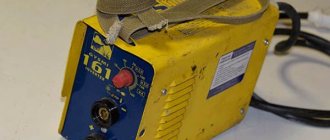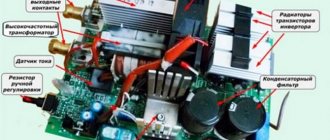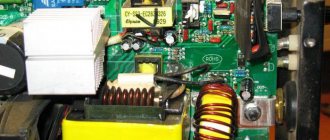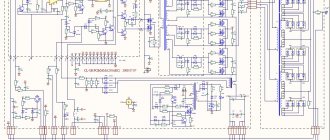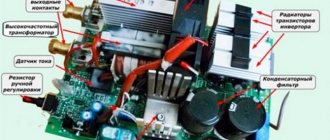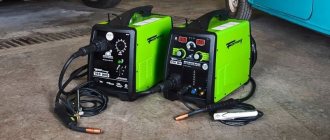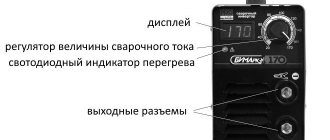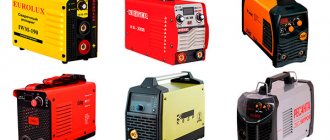The inverter, which replaced conventional welding transformers, is a modern electronic device, the characteristics of which allow it to be used for welding work using various technologies. In addition to the basic characteristics characteristic of transformer-type welding machines, inverters also have a number of additional capabilities, which makes their use more convenient and significantly expands their technical capabilities. Thanks to this, such equipment can be used equally successfully in both industrial and home environments.
Welding inverter “Svarog” ARC-200
Operating principle of the inverter
As already noted, inverters entered the practice of welding not so long ago, at the end of the twentieth century. The operation of devices of this type is based on the principle of voltage shift. This solution allows you to increase the strength and frequency of the current. It should be noted that the device of the inverter used for the work contains a rather complex circuit, within which the following processes are implemented:
Inverter welding machines
- The alternating current supplied to the inverter is converted to direct current. The change in current parameters occurs in the device, which is assembled using a diode bridge.
- The resulting current is transmitted to the inverter, which plays the role of a high-frequency pulse generator. In the transistor unit, the reverse conversion of direct current to alternating current occurs. But the resulting current has a significantly higher frequency than that coming from the power supply.
- High frequency current is supplied to the transformer. This device reduces the voltage and simultaneously increases the current. Since the transformer, which is used to work with high-frequency currents, has small dimensions, all this affects the overall weight characteristics of the inverter.
- After passing through the transformer, alternating current with new parameters is supplied to the rectifier, where it is again transformed into direct current, which is used for welding.
Welding with an inverter for beginners
It should be noted that inverter devices, unlike transformer-type devices, consume half the amount of energy. In addition, the parameters of the current that comes from the device ensure that the welding arc will have stable ignition and combustion during welding.
Safety instructions
Let's consider what is said about working with the device:
- It is not allowed to leave the device in the rain or snow, or to work in a room with a high level of humidity;
- Do not touch the operating machine with wet hands;
- The welding arc produces bright, visible light rays and invisible rays of the infrared and ultraviolet spectrum. Exposure to arc light on unprotected eyes for 10-20 seconds within a radius of 1 meter causes considerable pain in the eyes and fear of light. Longer exposure to arc light on unprotected eyes can cause serious illness. Invisible spectrum radiation can cause burns on uncovered areas of the body. Therefore, it is not allowed to work without a protective mask, gloves and special clothing covering open areas of the body;
- Adhere to the rules for wearing protective clothing, pocket flaps should be pulled up, buttons should be fastened, the jacket should not be tucked into pants, and pants should be worn over boots;
- When welding steels and non-ferrous metals, various gas compounds appear that have a bad effect on the health of the worker. Use PPE and ensure good ventilation at the work site;
- Do not allow surrounding objects to ignite under the influence of the welding arc or hot metal particles;
Do not work near flammable objects: paper, wood particles;
Care must be taken when welding on containers or pipelines that contain flammable or toxic substances. First, they are degassed, because fumes can cause an explosion or toxic poisoning.
Technical parameters of devices
Welding inverters have a number of specific characteristics by which one can judge its technological properties. These include the following parameters:
Welding inverter design
- The type of current that is generated at the output of the rectifier.
- The amount of voltage that is used to supply electricity. Manufacturers produce products that operate on 380 and 220 V. The former are used for professional welding, the latter for work at home.
- Current size, this parameter has a direct impact on the size of the electrode that will be used to perform the weld.
Technical parameters of welding inverter
- Unit power, this parameter provides information about the current and strength that will form the welding arc.
- Open circuit voltage, this parameter shows how quickly the welding arc will be produced.
- The range of electrode sizes that will be used for welding.
- Dimensional and weight characteristics of the inverter welding machine and the size of the welding current at the output. The lower the last indicator, the smaller the device, but accordingly such a device has lower performance characteristics.
Insufficient cross-section of extension cords
When welding at a considerable distance from the power outlet, it is impossible to do without the use of extension cords. Increasing the length of the power cable and choosing the wrong cross-section leads to a drop in power and a decrease in the voltage on the extension cord. The longer you use the carrier, the thicker the cable cores should be.
In order for the inverter to operate stable, it is necessary that the cross-section of the power cable and extension cord up to 10 m be the same. If the carrying distance is longer than 10 m, the cable cross-section must be increased compared to the inverter power cable. There are a large number of sites on the World Wide Web that offer free calculators for calculating cable cross-section by length and load. Under no circumstances should you install cables with a cross-section of 0.75 mm2, or use carriers wound in bobbins. All this can cause equipment failure. In general, when connecting the inverter to an electrical outlet, you need to make sure that the power of the power source is sufficient for stable operation of the welding inverter, and the cross-section of the power wires and carriers corresponds to the load; only in this case will the welder have a long and happy life.
Read the article from an experienced welder “How to choose the length and cross-section of the welding cable”
Pros and cons of inverter welding
Inverter devices show efficiency in the range of 85 - 95%, I must say that this is a high figure among electronic equipment. The circuit used allows you to adjust the level of welding current from several amperes to hundreds, or even thousands.
For example, an inverter of the MMA brand, it is 20 - 220 A. Inverters can operate for a long time. The power supply can be controlled remotely. The undoubted advantages of inverters include their small size and weight characteristics, which allow the device to be moved at the welding site. The design of the devices uses double insulation, ensuring electrical safety.
Technological advantages
The use of inverters allows the use of electrodes of any brand that work with both direct and alternating current. Devices of this type can be used for welding with a non-consumable electrode in a shielding gas environment. In addition, the design of this equipment makes it easy to automate welding processes.
Tungsten electrodes for argon arc welding
Electrodes for resistance welding
Welding can be performed using a short arc, thus reducing energy losses and increasing the quality of the weld; in particular, there is virtually no welding spatter on the surface of the parts being welded. By the way, the use of inverters allows you to produce seams in any spatial configuration.
Microprocessor
Microprocessors are used to control modern welding inverters, and this ensures a stable connection between voltage and current.
Disadvantages of inverters
Inverters are somewhat more difficult to repair than traditional transformer units. If some control elements located on the board fail, repairs can cost about a third of the cost of a new welding inverter.
Inverters, unlike other types of equipment, are very susceptible to dust. That is, such devices must be serviced more often. Operation of an inverter welding machine is also limited by low temperatures. In addition, there are some restrictions on storing the inverter at sub-zero temperatures. This is fraught with the formation of condensation, which can lead to a short circuit on the board.
How to choose a 220 V welding machine for home and garden
When selecting welding equipment, the consumer must decide what tasks it will be needed for.
If it is used for repairing body parts, then it should have some parameters, and if it is used for the production of metal structures, then it should have different parameters. But in any case, the devices must meet a number of requirements, in particular, functions such as hot start, anti-sticking and some others must be implemented in a home device. This is how inverters differ from traditional devices.
A fan must be installed in the design of this type of device. In addition, the circuit must be protected from power surges. In principle, a device with such parameters can work both in a home workshop and in industrial production conditions.
Saving
If you use the device frequently, you should store it in a box made of cardboard materials. Do not place the box where there is moisture.
It is better to store the kit in dry places away from water and sunlight. You should regularly wipe the device from dust and dirt and protect it from moisture.
If you rarely use the inverter, you should wrap it in polyethylene film. Make small holes in it and leave the device in the box. The device must not be allowed to overcool.
Inverter classification
Welding inverters can be classified by the size of the welding current. Manufacturers produce three types of devices:
- 100-160 A – low-power;
- 160-200 A - average;
- 200-250 A - powerful.
There is a relationship between the size of the current and the dimensions of the device. When choosing a device for use at home, you should be guided by the tasks that they have to solve.
The weakest devices can be classified as devices of the lowest level; many use them to gain work skills. Devices that are classified as middle class are among the most popular and allow you to perform a wide variety of work, from assembling a fence and manufacturing quite complex metal structures. The most powerful devices are mostly used for production purposes. They are used for working with rolled metal of large thickness.
Electrodes for manual arc welding
Most inverters are designed to work with coated electrodes. But they can also be used to work with welding wire. To do this, a device is installed on the device that feeds the wire into the welding zone. The wire is fed through the welding gun, and the gas mixture is also fed through it, protecting the working area from exposure to atmospheric air.
Additional functions in inverters
Modern inverter devices implement some options that significantly facilitate the welder’s work:
- Hot start - often novice welders, and not only them, have difficulty igniting and maintaining the arc in working condition. At the moment of ignition, the current rises to the required level and immediately after ignition returns to operating parameters. The process of changing the current occurs completely automatically, without the participation of the welder.
- Another problem that plagues beginners is electrode sticking. There are several reasons for this, but there is only one solution - reducing the level of welding current. This operation is also performed automatically.
- Arc forcing allows you to make seams in different spatial positions.
- Reducing the no-load voltage to a level that is safe for the worker and his surrounding people.
Determining the characteristics
Like any technical equipment, welding inverters have a number of technical parameters that determine their capabilities.
Welding current
Inverter welding machines provide the generation of welding current in the range from 100 to 250 A.
Open circuit voltage
After converting the current supplied from the electrical network to 220 V, a current with a voltage of 50 - 90 V and an operating frequency of 20 - 50 kHz is obtained at the output of the device. Maximum voltage must be used to ignite the arc, but this creates a safety hazard for the welder and surrounding people. Therefore, after finishing work, the voltage drops to a safe level.
Maximum current operating mode
An important indicator of the operation of any welding machine is the operating time. It may be called PN or PV. This indicator indicates how long the device will operate with a ten-minute welding cycle before shutting down.
In other words, if the duty cycle is 50%, this means that the effective operating time will be 5 minutes, if the indicator is 70%, then the time will be 7 minutes. This indicator must be reflected in the technical documentation included in the delivery of the welding machine.
Power deficit
For example, you have a personal garage in a garage cooperative that requires 3 kW of electrical power, and a welder requires 5-6 kW, in which case the device will soon become inoperable. How can this happen? Let's say your garage cooperative, consisting of 20 garages, has a 25 kVA (20 kW) transformer installed. This means that each garage has approximately 1kW of allocated power. Even if we imagine that half of the garages are uninhabited, and the owners of the second half are rarely in their garages at the same time, then even in this case 20 kW is very little! Let’s imagine that 1 kW of energy is spent on powering light bulbs, another 6 kW is spent by two car enthusiasts on heating using infrared heaters, three car owners work with angle grinders, and one decided to get a welding transformer from the pantry in order to cook the fence sections, the installation of which is supposed to take place in soon at the summer cottage. It turns out that 6 garage boxes consume 17 kW of energy and if you need to connect a welding machine with a power of 5-6 kW, then it definitely won’t have enough power!


